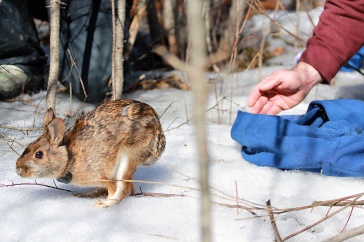UNH Researchers Track Success of New England Cottontail Reintroduction

A New England cottontail with a radio tracking collar is released into outdoor captive breeding pen at the Great Bay National Wildlife Refuge in Newington. Credit: New Hampshire Fish & Game.
DURHAM, N.H.—Researchers with the New Hampshire Agricultural Experiment Station at the University of New Hampshire monitoring the reintroduction of New England cottontails raised in captivity into the wild used DNA to find the reintroduced rabbits survived and bred in the wild over multiple years. The reintroduction by wildlife biologists was the first attempt at releasing captively bred New England cottontails into the wild.
“We learned that captively reared New England cottontails released in the wild bred successfully, as did their wild-born offspring,” said Adrienne Kovach, associate professor in natural resources and the environment. “This led to growth of the population and subsequent dispersal of individuals to a nearby patch about 700 meters away. This is an important measure of success, given the low documented dispersal rates in the wild.”
The New England cottontail is an endangered species in New Hampshire and a high conservation priority species throughout the Northeast. Populations in New Hampshire have declined to very low levels in the past few decades, and it is estimated that there are fewer than 100 cottontails in the state today.
Extensive New England cottontail conservation efforts have been underway for the last decade, including habitat management and restoration, the creation of new habitat and captive breeding. Because the species has declined to such low levels in the New Hampshire Seacoast region, reintroduction of captively bred rabbits was determined to be necessary to help the population rebound and boost genetic diversity.
Doctoral student Melissa Bauer worked with Kovach to track the outcome of a reintroduction of 42 cottontails over five years to the Bellamy River Wildlife Management Area in Dover. Of the original 42 rabbits released, six bred in the wild, along with nine of their offspring, resulting in at least 29 wild-born rabbits. Integrating the genetic data with data from rabbits collared by New Hampshire Fish & Game biologists it was also determined that only a small percentage of the original rabbits released survived long enough to reproduce, and survival was highest in the year of the initial release.
Researchers released the rabbits in late summer and early fall. Rabbits need to survive through the winter to the next spring to reproduce. While the survival and reproduction of reintroduced cottontails is an important success, the reintroduction is not yet self-sustaining.
“A single reintroduction was not sufficient to keep this isolated population persisting robustly,” said Kovach. “In the absence of natural immigration, multiple releases of cottontails are needed to prevent negative consequences of unpredictable events, such as mortality during winter snowstorms.”
This material is based upon work supported by the NH Agricultural Experiment Station, through joint funding of the National Institute of Food and Agriculture, U.S. Department of Agriculture, under award number 1006954, and the state of New Hampshire.
Founded in 1887, the NH Agricultural Experiment Station at the UNH College of Life Sciences and Agriculture is UNH’s original research center and an elemental component of New Hampshire's land-grant university heritage and mission.
The University of New Hampshire inspires innovation and transforms lives in our state, nation and world. More than 16,000 students from all 50 states and 71 countries engage with an award-winning faculty in top-ranked programs in business, engineering, law, health and human services, liberal arts and the sciences across more than 200 programs of study. As one of the nation’s highest-performing research universities, UNH partners with NASA, NOAA, NSF and NIH, and receives more than $110 million in competitive external funding every year to further explore and define the frontiers of land, sea and space.
PHOTO AVAILABLE FOR DOWNLOAD
https://colsa.unh.edu/nhaes/sites/default/files/media/images/necrelease.jpg
A New England cottontail with a radio tracking collar is released into outdoor captive breeding pen at the Great Bay National Wildlife Refuge in Newington. Credit: New Hampshire Fish & Game.
-
Media Contact
Lori Tyler Gula, PhD | NH Agricultural Experiment Station | lori.gula@unh.edu | 603-862-1452
Latest News
-
November 6, 2025
-
November 5, 2025
-
October 24, 2025
-
October 8, 2025
-
October 2, 2025













































